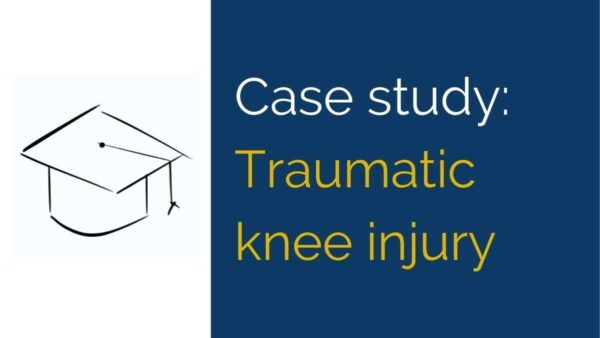Background
This acute knee injury case study focuses on the validity and reliability of Physiotherapy physical examination and special test of the knee. We present the most effective approach to an acute knee injury examination including the best special test or tests to use for each pathology.
Minimum Level
Physiotherapist with 3+ years experience
History
Jerry is a 22 year old male who plays competitive Rugby on weekends. He also trains for Rugby with field sessions and gym training each week.
Does this information assist in narrowing your list of potential pathologies?
Two days ago, Jerry was playing Rugby when we twisted awkwardly in a tackle. He is unsure of the exact movement or mechanism of injury but describes immediate pain in his Right knee. He walked off the field immediately as he knew he was unable to play on.
Given this mechanism and description of an acute knee injury, explain how you’ve further refined your list of potential pathologies.
Jerry’s knee showed signs of swelling within an hour and was significantly swollen by the evening, 6 hours after the game.
Does this pattern of swelling raise any concerns?
The knee aches constantly at rest and Jerry found the most comfortable position to be around 30 degrees flexion and well supported.
Explain what might be causing these observations.
He took two anti-inflammatory tablets that night (2 x 25mg Diclofenac) and again the following morning.
What effect would you expect the medication to have on Jerry’s presentation?
Jerry has moderate pain on walking today and feels nervous on stairs.
Do these observations change your diagnostic hierarchy at this stage?
Jerry has not had any knee pain or an acute knee injury before and only reports a sprained ankle 2-3 years ago as his previous injuries.
Physical Examination
Jerry walks with a distinct limp and describes loading the leg as moderately painful. He maintains a fixed 30 degrees Right knee flexion during walking and is unable to extend the knee after being prompted.
What might account for Jerry’s fixed knee position? Give two possible explanations.
He can single leg stand on the Right leg but maintains the fixed flexion position.
Does this make any fracture locations much less likely? Are there any fracture locations that are still of concern?
He is unable to single leg squat on his Right leg due to concern about pain.
How would you interpret this test result?
His passive range is 20-100 degrees with moderate pain at either end of this range. His range is limited by a combination of pain and “knee tightness”.
Explain how this limited range does/doesn’t assist you in further limiting your diagnostic hypotheses.
Jerry describes an increase in his resting symptoms after those tests so you decide to move straight to special tests.
Special Tests- Acute knee injury
For each acute knee injury pathology:
- What key findings in a history would support this diagnosis?
- Which test or tests would you perform for that pathology?
- Explain the value of each test in confirming or excluding that pathology.
- Also explain why false results may occur with that test.
PCL & Posterolateral corner injury?
MCL injury?
Fractures?
Like to continue the conversation? Head over to our Facebook page.

